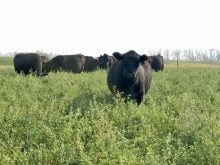All food animal veterinary clinics across Canada recently received a set of guidelines on antimicrobial prudent use. The list includes beef and dairy cattle as well as swine and poultry veterinarians. The guide was published after extensive research and collaboration with veterinary and industry stakeholders. The Canadian Veterinary Medical Association (CVMA), which developed and distributed this document, deserves praise for a job well done.
Everyone involved with food production is part of a team ensuring not only the safety of the food but also that antimicrobial usage is justified. Your veterinarian needs to select and prescribe the proper medication for the condition he or she is treating. This is based on knowing the disease process, the bacteria that are likely involved, and which drug has been proven to be of value on the farm previously. The proper dosage, drug withdrawal, and method or route of administration must be clear. There are also conditions which are not caused by bacteria where antibiotics will be of no value and should not be prescribed (e.g. viral or parasitic conditions).
Read Also

Canada’s slaughter horse industry lacks transparency
Horse slaughter is a fraught issue right now in the Canadian livestock sphere. The author writes that, while it has a role, traceability, transparency and humane handling must be in play.
The majority of drugs used in veterinary or human medicine are for the control, treatment, or in some cases, the prevention of disease. Unlike human medicine, veterinarians may use some for their growth promotant properties. Several of the antimicrobials used in veterinary medicine are also used in serious or life-threatening situations in human medicine. Health Canada has categorized these antimicrobials as Category I (highly important in human medicine) through to Category IV (low importance in human medicine.)
I believe most veterinarians use antimicrobials judiciously. The CVMA Antimicrobial Prudent Use Guidelines will help veterinarians select the appropriate antimicrobial for the disease they are treating. If the condition will respond favourably to a product in the higher numbered categories, then stay with that. Save the ‘big guns’ (Category I) for when your veterinarian feels their use is justified.
The veterinary profession as well the farmers and ranchers buy into this concept fairly well, I think. The flip side is the medical doctors. I have seen some of them prescribe some pretty big guns rather than going to the second or third choice. If a condition is viral or fungal, then specialized medication should be used and not necessarily antibiotics. A word of advice for medical community: Save the big guns for treating the serious life-threatening infections in people and please don’t overprescribe.
In veterinary medicine, once we or the producer arrive at a diagnosis, there are usually three or four choices of medication which are effective. Using category II-IV antimicrobials for the easier to treat or for low-grade infections keeps the higher choices for when we really need them. If products are not overused or, when used, are dosed correctly, it is much less likely for disease resistance to build up.
The guide will also come into play in the licensing of products and determine the degree of scrutiny they will face. Those in Category I with the potential for use in human medicine will be much more controlled. Some examples today of antimicrobials in Category I are the family of fluoroquinolones and cephalosporins (third and fourth generation). I don’t want to name products here but your veterinarian can best inform you as to which ones they carry.
This cautious approach should be taken by your small animal veterinarian as well. They shouldn’t prescribe powerful antibiotics for minor infections, or prescribe them for too long for non-responsive chronic ailments.
The good news is we have significantly reduced the use of antibiotics through better animal husbandry and nutrition; preconditioning to minimize stress; and maximizing disease resistance through vaccination. With experienced producers catching diseases earlier, the course of treatment is generally shorter yet more effective.
New-generation antibiotics are more expensive, and so taking this approach may even save you money. Expensive products are seldom overdosed but we want to dose properly and not under-dose either. Make sure your weights are accurate. Work with your herd veterinarian and ask them their opinion on the CVMA Antimicrobial Prudent Use Guidelines. It will stimulate some interesting discussions and make us all more aware of the great importance of preventing antibacterial resistance.
———
TheCVMA,which developedand distributedthis document,deserves praiseforajobwell done.















